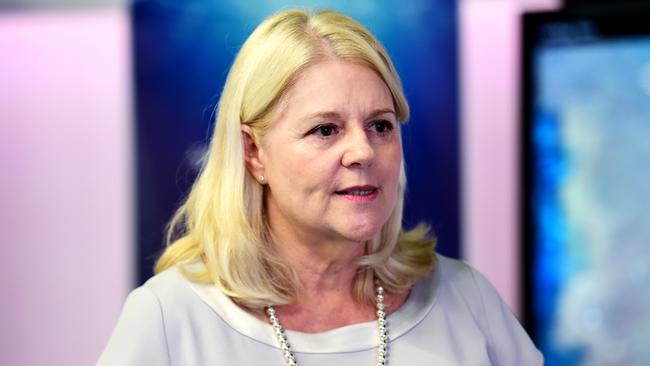Urgent call to fix crisis in construction industry
Five of Australia’s largest business groups are demanding federal government intervention to push reform of the building industry.

Five of Australia’s largest business groups are demanding urgent federal government intervention to push reform of the building industry, warning that a flawed regime of state regulations and skyrocketing insurance premiums pose a threat to the national economy.
The groups have voiced their deep dissatisfaction to federal Industry Minister Karen Andrews ahead of a meeting she will chair this week with state counterparts that will focus on the inability of many private building certifiers and surveyors to obtain compulsory insurance.
In a letter to the minister, the five signatories stress the need to renew “public confidence” in the nation’s building industry as the sector that “provides the most full-time jobs” and contributes more than 7 per cent of GDP as “a vital engine room of economic growth”.
The five groups — Master Builders Australia, the Australian Industry Group, the Insurance Council of Australia, the Property Council of Australia and the Australian Construction Industry Forum — are disturbed at a failure of “lagging” states to deal with a crisis they say confronts frontline practitioners in the building supply chain.
MBA chief executive Denita Wawn said the inability of many private building certifiers to gain professional indemnity insurance in the wake of apartment block disasters in Sydney and Melbourne meant the building industry was “grinding to a halt”.
“Up to 30 per cent of insurance renewals for building certifiers and surveyors may not be renewed this month,” Ms Wawn said. “The consequence will be building activity grinding to a halt, resulting in huge damage to our members’ businesses and the economy.”
Ai Group chief executive Innes Willox said formulation of uniform regulations was “urgent” in the national interest to maintain public confidence.
Certifiers who have been able to secure indemnity insurance renewals have experienced huge jumps in premium costs, with annual payments for medium-size private certifying businesses with the job of approving key stages of construction projects increasing 10 times or more.
One certifier from Sydney’s west, Troy Myers from Urban City Consulting, told The Australian that the premiums for his business with 12 staff, including three accredited certifiers, had risen from $18,000 12 months ago to $220,000 for this year’s renewal.
Driving the escalation of indemnity insurance costs, which certifiers say they will be forced to pass on to consumers, is much higher premiums charged by the few remaining operators in the insurers’ market as the discovery of more apartment building cracks and the past widespread use of flammable cladding leads to remedial action and increased damages payouts.
The building industry has been undergoing strain with private home construction approvals down 3.2 per cent in March, according to ABS figures. Private dwelling approvals, excluding houses, fell by as much as 30.6 per cent.
Ms Wawn said the building industry was “sick and tired” of inaction by state governments that were overseeing a crisis by failing to implement recommendations of a report co-written by Peter Shergold, a top bureaucrat in the former Howard and Rudd governments.
Liability for damages claims for individual apartment blocks running to millions of dollars has scared off insurers, while certifiers still able to remain in the industry have done so at considerable cost.
NSW Better Regulation Minister Kevin Anderson said his government was taking the lead to ease difficulties by giving certifiers a 12-month exemption from cladding “at serious risk of combustion” to ensure most certifiers could access insurance this financial year.
Mr Anderson said the NSW government was also working on a range of “medium- and long-term solutions” to help manage indemnity insurance costs.
These are understood to include proposed legislation spreading the insurance load by extending mandatory accreditation and insurance coverage to all parts of the building sector — including architects, designers, fire-proofers and engineers — in addition to certifiers and surveyors already subject to mandatory licensing rules.
The NSW government, while accepting some oversight from Canberra, believes regulation of the building industry is best kept as a state responsibility, even if nationally consistent rules are adopted.
However, Victorian Planning Minister Richard Wynne appeared to put more onus on Canberra’s role, saying a “national approach” was the only way to solve the insurance crisis.
“We are well aware of building insurance concerns and will continue lobbying for a national solution,” he said. “Nationwide action to give the building industry more certainty and bipartisanship to get rid of combustible cladding are my priorities for the next (ministers’) forum.”
In their letter to Ms Andrews, the five business groups said positive action had been taken in “some jurisdictions” but blasted other states for lagging.
“The continued inconsistency in the approach across government is manifesting in the crisis confronting building practitioners in the building supply chain.
“This has led to significant increases in professional indemnity premiums, and a reduction in cover via exclusions on combustible cladding and non-conforming building products.
“Building surveyors, engineers and architects are now struggling to obtain the insurance they need to do their job, which in turn could in turn seriously affect future building or construction activity.
“Consumers, building owners, building practitioners and their insurers need certainty and confidence in building regulation.”
Ms Wawn blamed the insurance industry’s inability to properly assess exposure to claims arising from non-compliant cladding.




To join the conversation, please log in. Don't have an account? Register
Join the conversation, you are commenting as Logout